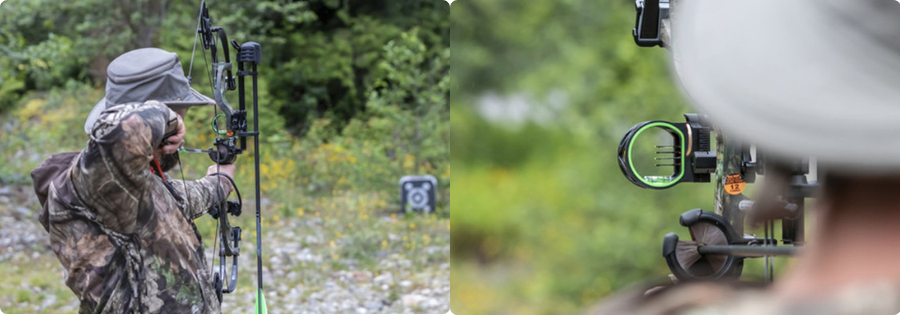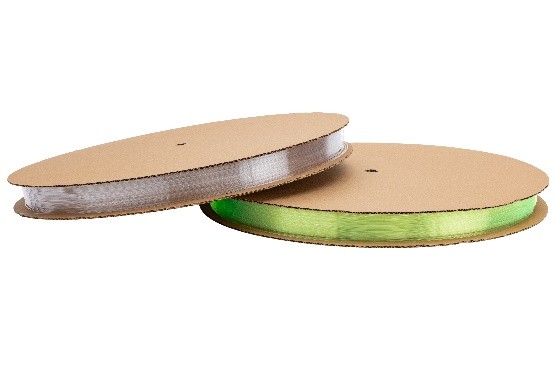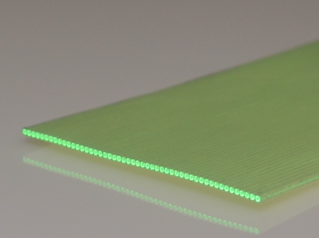BCF-XL Series
Starting in 2023, Luxium Solutions introduced the BCF-XL series of scintillating and wavelength shifting fibers with improved, market-leading attenuation length for optimal, reliable performance for a variety of different applications. Properties of our BCF-XL fiber formulations can be found in the table below.
Current sizes range from 0.5 mm to 3 mm round cross-sections and are available in canes, spools, ribbons, and arrays. Custom sizes and designs are available upon request. Fibers > 2mm are available only in cane form to prevent the fiber from retaining the shape of the spool.
Scintillating fibers are well-suited for such applications as Industrial gauging, Calorimeters, Real-time imaging systems.
The flexibility of fibers allows them to conform to surface shapes, yielding geometries superior to those of other types of detectors. Examples are detectors for monitoring pipes or barrels.
Fibers
- Applications
- Scintillating Fibers
- Wavelength-Shifting Fibers
- Material & Structure
- Forms/Configurations
High Energy Physics (HEP)
Calorimeters and tracking systems (trackers) are two of the most common HEP systems that use scintillating and wavelength-shifting (WLS) fibers.
Calorimeters measure the energy of electrons, photons and hadrons. The electromagnetic calorimeter (ECAL) and the hadronic calorimeter (HCAL) are two significant calorimeters that make up part of most modern high energy physics detectors. Most large, modern detectors have both an electromagnetic calorimeter and a hadronic calorimeter.

Tracking systems are used to track the trajectory of electrically charged particles within particle detectors. Historically, these types of systems were solid state trackers (also known as silicon trackers), which began in 1980 with the advent of semiconductors.
Due to improvements in SiPM technology, scintillating fiber trackers are becoming more widespread and offer significant benefits over silicon trackers. These include a faster, lower cost, flexible detector that can operate in radiation hard environments with similar resolution to silicon trackers.
Muon Detection
What is a Muon? Muons are found in the cosmic radiation near the earth’s surface. Scintillating fibers are an efficient material for utilizing muons to visualize and inspect bridge structures. This muon tomography technology is new and will continue to improve for use in many other applications.
Fibers have been used in canes spools and ribbons as a great solution for these projects.
Industrial Gauging
Our fibers are used in conjunction with an x-ray source to measure the contents within enclosed containers. Breweries to chemical suppliers and beyond, the need to measure the contents within enclosed containers without exposure or contamination.
Recreation
A little-known use for "colored" fiber is for bow site archery. The fiber collects the low ambient light to provide a lighted site pin to line up the target.

The BCF-XL series of scintillating fibers has improved, market-leading attenuation length for optimal, reliable performance in a wide range of applications. Additionally, Luxium can customize new formulations to meet your specific needs.
Formulations
| Fiber Type | Emission Color | Emission Peak, nm | Decay Time, ns | # of Photons per MeV* |
Attenuation Length (m)** |
Characteristics / Applications |
|---|---|---|---|---|---|---|
| BCF-10XL | blue | 432 | 2.7 | ~8000 | >4 | General-purpose; optimized for diameters >250μm |
| BCF-12XL | blue | 435 | 3.2 | ~8000 | >4 | Improved transmission for use in long lengths |
| BCF-9998XL | blue | 435 | 3.2 | ~8000 | >4 | Scintillating fiber, optimized for maximum light output in short length canes (<0.5m) |
| BCF-20XL | green | 492 | 2.7 | ~8000 | >4 | Fast green scintillator |
| BCF-60XL | green | 530 | 7 | ~7100 | >4 | 3HF formulation for radiation hardness |
* For Minimum Ionizing Particle (MIP), corrected for PMT sensitivity
** For 1mm diameter fiber, measured using Silicon Photodiode
Emission Spectra


Samples
Luxium Solutions provides the following scintillating fiber samples in 0.5mm or 1.00mm diameter in 1m length canes. Custom diameters and lengths may be available upon request.
BCF-12XL
BCF-9998XL
BCF-20XL
BCF-60XL
The BCF-XL series of wavelength-shifting fibers has improved, market-leading attenuation length for optimal, reliable performance in a wide range of applications. Additionally, Luxium can customize new formulations to meet your specific needs.
Formulations
| Fiber Type | Emission Color | Emission Peak, nm | Decay Time, ns | # of Photons per MeV* |
Attenuation Length (m)** |
Characteristics / Applications |
|---|---|---|---|---|---|---|
| BCF-91AXL | green | 494 | 12 | n/a | >4 | Shifts blue to green |
| BCF-92XL | green | 492 | 2.7 | n/a | >4 | Fast blue to green shifter |
| BCF-9929AXL | green | 492 | 2.7 | n/a | >4 | Blue to green shifter. Pairs well when exciting wavelengths are >425nm (e.g. injection-molded and extruded scintillators) |
| BCF-9995XL | blue | 450 | 2.7 | n/a | >4 | UV to blue shifter |
| BCF-9906AXL | orange | 540 | 21.6 | n/a | - | Green to orange shifter |
| BCF-99172XL | red | 605 | 22.6 | n/a | - | Green to red shifter |
Optical Fibers
| Fiber Type | Emission Color | Emission Peak, nm | Decay Time, ns | # of Photons per MeV* |
Attenuation Length (m)** |
Characteristics / Applications |
|---|---|---|---|---|---|---|
| BCF-98XL | n/a | n/a | n/a | n/a | Not Available | Clear waveguide |
* For Minimum Ionizing Particle (MIP), corrected for PMT sensitivity
** For 1mm diameter fiber, measured using Silicon Photodiode
Absorption and Emission Spectra



Samples
Luxium Solutions provides the following scintillating fiber samples in 0.5mm or 1.00mm diameter in 1m length canes. Custom diameters and lengths may be available upon request.
BCF-9995XL
BCF-91AXL
BCF-92XL
BCF-9929AXL
The BCF-XL series of wavelength-shifting fibers has improved, market-leading attenuation length for optimal, reliable performance in a wide range of applications. Additionally, Luxium can customize new formulations to meet your specific needs.
Core:
The scintillating core is polystyrene-based and contains a combination of fluorescent dopants selected to produce the desired scintillation, optical and radiation resistance characteristics. Often, one property is enhanced while another is mildly compromised. In small fibers (< 0.5mm), the fluor concentration may be increased on request, usually at the expense of light attenuation length. These fibers yield about 8,000 photons per MeV deposited.
Core Specifications |
Value |
| Core Material | Polystyrene |
| Core Refractive Index | 1.60 |
| Density | 1.05 g/cm3 |
| No. of H Atoms per CC | 4.82 x 1022 |
| No. of C Atoms per CC | 4.85 x 1022 |
| No. of Electrons per CC | 3.4 x 1023 |
| Operating Temperature | -20°C to +50°C |
| Vacuum Compatible | Yes |
Cladding:
PMMA (polymethylmethacrylate, C5 H8 O2) is the standard cladding material for Luxium Solutions’ fibers. It has a density of 1.2 g/cc and a refractive index of 1.49. The refractive indices of the core and cladding and the cross sectional shape of the fiber determine the trapping efficiency. In round fibers, the trapping efficiency also depends on the distance between the fiber axis and the scintillation event. The trapping efficiency of Luxium Solutions’ round fibers ranges from 3.4% for events occurring at the fiber axis to approximately 7% for events near the core-cladding interface.
Core Specifications |
Value |
| Cladding Material | Acrylic |
| Cladding Refractive Index | 1.49 |
| Cladding Thickness (Round Fibers) | 3% of Fiber Diameter |
| Numerical Aperture | 0.58 |
| Trapping Efficiency (Round Fibers) | 3.44% Minimum |
| Radiation Length | 42 cm |
Cross-section:
All Luxium fiber formulations can be manufactured in round or square dimensons.
Round Fiber Specifications |
Value |
| Available Diameters* | 0.5 - 3mm |
| Diameter Tolerance | +/- 2% |
| Trapping Efficiency | 3.44% Minimum |
| Cladding Thickness | 3% of Fiber Diameter |
* Diameters outside this range could be considered based on business justification/feasibility.
Luxium fibers are available in spools, canes or ribbons and can manufactured to various dimensions.
Spools
- Available in 0.5 – 2mm diameter (>2mm diameter cannot be spooled, must be canes)
- Diameters outside this range could be considered based on business justification/feasibility

Canes
- Available in 0.5 – 4.5m* lengths
- Available in rough-cut (standard) or diamond-milled end finish (additional cost)
- Rough cut end length tolerance: +2/-0 mm
- Diamond-milled end length tolerance: +/- 0.25mm
Ribbons

- Available for all standard formulations and sizes
- Standard Ribbon Length: 50 (2”) – 3300 (130”) mm
- Width: 508mm (20”) maximum
- Ribbon standard end finish options
- Rough-Cut Finish: +/- 12.7mm (+/- 0.5”)
- Diamond-Mill Finish:
- <2m ribbon length: +/- 0.25mm
- >2m ribbon length: +/- 1mm
Frequently Asked Questions
Are fibers sensitive to Neutrons?
All scintillating fibers are sensitive to fast neutrons through proton recoil.
How is fiber light output defined?
We define the light output as # of photons per MeV for minimum ionizing Particle, which is approximately 8000 for BCF-12. The more densely ionizing particles emits less light than per unit energy.
What is the fiber spool size?
Fiber is wound on a spool that measures 30" (762mm) outer diameter x 27.4" (698.5mm) core x 2.25" (57mm) with 1" (50.8mm) center hole. It will fit 1000 meters of 1mm fiber.
What is the lower temperature limit of Scintillating Fiber?
The lower limit on operating temperature has not been set, but research experiments have used fiber in temperatures down to about 4 degrees K. Fiber will lose their flexibility at low temperatures.
What is the typical bend radius of a scintillating fiber
The typical bend radius is 30-40 times the diameter of the fiber.


